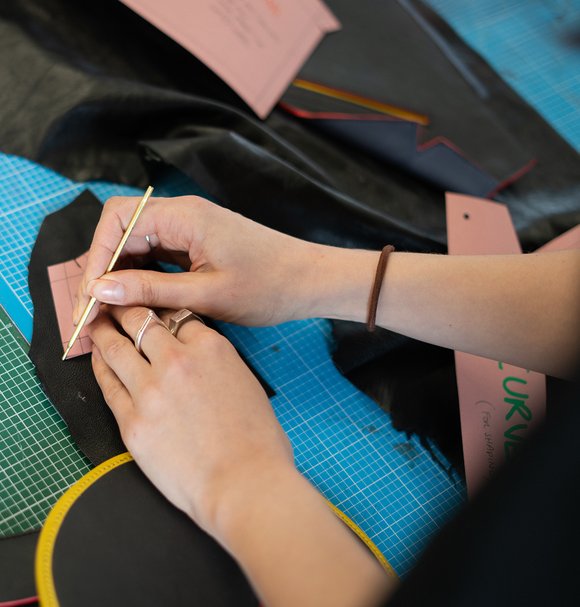
Key details
Date
- 3 May 2023
Read time
- 3 minutes
The fashion industry is transforming. Read how one of our MA Fashion students is using her time at the RCA to contribute to that evolution.
Key details
Date
- 3 May 2023
Read time
- 3 minutes
For Morag Seaton, who is from Edinburgh, Scotland, studying fashion felt inevitable; she has been sewing and making clothes since she was little. However, she was driven to study MA Fashion at the RCA because she wanted to take time to navigate and challenge what is wrong with the fashion industry.

How would you sum up your creative process in one sentence?
Abstract pockets, tailoring, fashion systems and speculative design led by conversations with people about their everyday clothes.
What brought you to studying Fashion at the RCA?
How we understand, create and communicate fashion is shifting, and I wanted to be a part of that change, which is why I decided to apply to the RCA.

“Being able to create outside of the confines of industry is a huge privilege”
MA Fashion student
After your BA you worked across fashion production, arts and culture sectors and garment technology. Why did you decide to do a Master’s?
I was full of questions about fashion and the world, without having the time or space or community to help answer them. Being able to create outside of the confines of industry is a huge privilege, and I felt incredibly fortunate to be able to do a Master’s after some time in the ‘real world’.
Working in different industries really highlights how much is wrong with fashion. From the excessive waste, environmental impact and all of the unstable social-cultural, and political structures it enforces. Taking the time to navigate this, whether through education or elsewhere, felt really important.


You co-run Worn, an organisation that engages people with the emotional and environmental significance of their clothes. How do you go about achieving these aims and why is this important?
We run interview-led projects and workshops that use discussion, drawing and other creative ways to help people understand and explore their relationships with their clothes. The more we understand about our clothes, the less we will impulsively buy or dispose of them. And, importantly, the more we will value and care for the people and skills that pass through a single garment.
“The more we understand about our clothes, the less we will impulsively buy or dispose of them.”
MA Fashion student
What are you working on right now?
I’ve been doing different projects and experiments that will eventually become ‘Chapters’ of the Archive I am building: a growing collection of exchanges and responses to the questions I ask people about their relationships to their clothes. I am primarily a maker, so all of this is translated into fashion artefacts and objects that hopefully communicate both the sincere and playful aspects of the Archive.


“What is interesting about the Fashion programme is that there is no requirement to make clothes or a typical fashion collection.”
MA Fashion student
How does the Fashion programme challenge you to expand your practice?
What is interesting about the Fashion programme is that there is no requirement to make clothes or a typical fashion collection. This alone has helped challenge my understanding and preconception of what fashion is and can be, which is incredibly exciting.
Have you been introduced to new ways of making or working through the facilities that are available at the College?
Absolutely, I’ve had the opportunity to work with technicians and facilities across fashion, leather, 3D modelling (CNC), photography and more. While I think it’s important to look beyond the sewing machine, especially when thinking about the future of fashion, it is still a piece of equipment I hugely value and love going back to every day.

Where do you socialise at the College?
Most corners of the fashion studio, and usually during late nights in the ateliers or Art Bar.
What is the best thing about studying in London?
It doesn’t matter what strange piece of material, information, person or food you are looking for, the chances are you will definitely find it in London.


What do you have planned for your time post-RCA?
Most of the projects I have been developing here are ongoing, so I am excited to expand them into production and to continue facilitating more collaborations post-RCA. I don't like planning too far ahead, but if I'm still making pockets and doing public engagement work in a year's time I will be happy.
Have there been any chances to connect with individuals from your industry on the programme, and how has this shaped your plans for the future?
I met the team at the UKRI Textiles Circularity Centre at the RCA. It was a pleasure working with them on their configurator platform and I was given the opportunity to develop and make a modular shirt system. It definitely opened up whole new areas of research that weren't accessible to me before. I've also had the opportunity to work with industry people across fragrance, material archives, eyewear and leather innovation which has been incredibly valuable.

